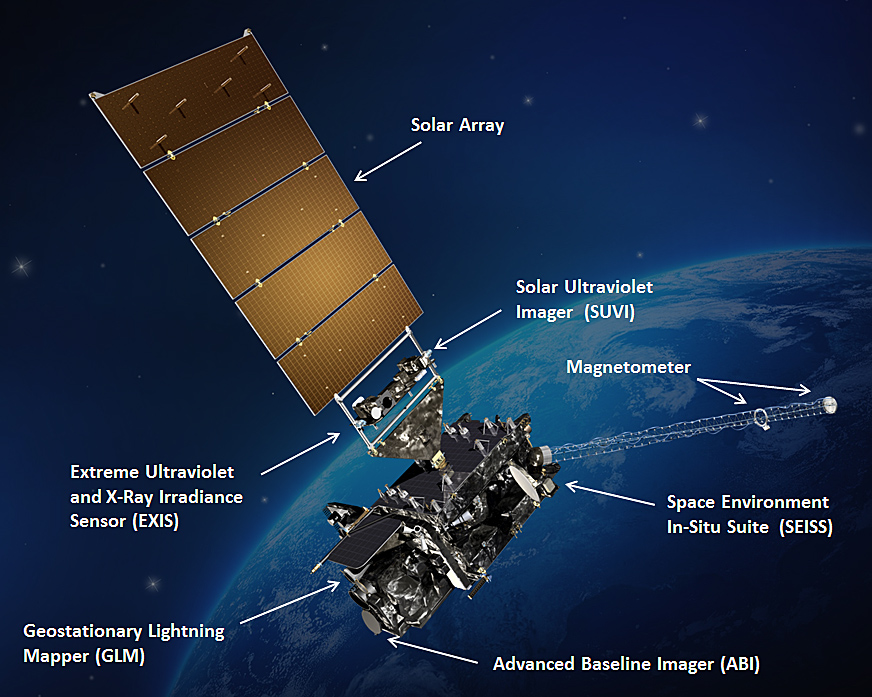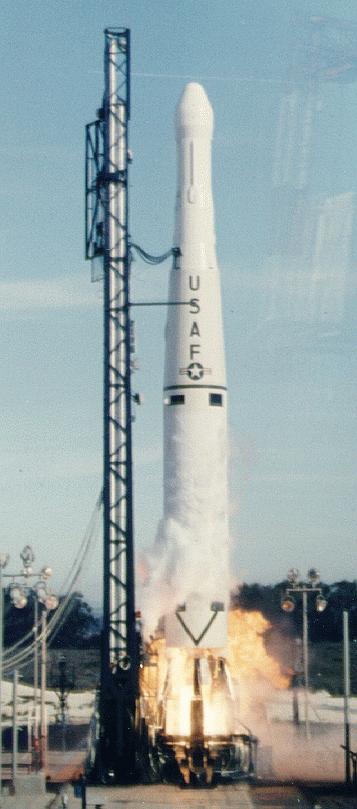|
Thor DSV-2U
The Thor DSV-2U or Thor LV-2F Star-37XE Star-37S-ISS was an American expendable launch system used to launch five DMSP weather satellites between 1976 and 1980. It was a member of the Thor family of rockets, and a derivative of the Thor DSV-2. The first stage was a Thor missile in the DM-19 configuration. A Star-37XE was used as the second stage, and the third stage was a Star-37S-ISS. Thor boosters used an erector system to hoist them up to the pad. While common on Soviet launch vehicles, this method was unusual in the US space program. Launches Thor DSV-2U was launched five times between 1976 and 1980 from Space Launch Complex 10W at the Vandenberg Air Force Base. All launches carried DMSP 5D-1 satellites The final launch (Thor 304) occurred on July 14, 1980 and was a failure. Thor 304 failure Thor 304 had been erected on the pad a few weeks before launch, and during this step, a connecting pin in the erector broke and sent the rocket falling back down to ground le ... [...More Info...] [...Related Items...] OR: [Wikipedia] [Google] [Baidu] |
Defense Meteorological Satellite Program
The Defense Meteorological Satellite Program (DMSP) monitors meteorological, oceanographic, and solar-terrestrial physics for the United States Department of Defense. The program is managed by the United States Space Force with on-orbit operations provided by the National Oceanic and Atmospheric Administration (NOAA). The (originally classified) mission of the satellites was revealed in March 1973. They provide cloud cover imagery from polar orbits that are Sun-synchronous at nominal altitude of . History Early in 1963 The Aerospace Corporation recommended that the U.S. Air Force develop a dedicated military meterological satellite, and the Defense Department agreed. The main emphasis would be on cloud-cover photography, but planners expected to add more sophisticated equipment when it became available. Later, when civilian weather satellites improved their capabilities and could satisfy most military requirements, the Defense Department continued to prefer a separate sys ... [...More Info...] [...Related Items...] OR: [Wikipedia] [Google] [Baidu] |
Expendable Launch System
An expendable launch system (or expendable launch vehicle/ELV) is a launch vehicle that can be launched only once, after which its components are destroyed during reentry or impact with Earth, or discarded in space. ELVs typically consist of several rocket stages that are discarded sequentially as their fuel is exhausted and the vehicle gains altitude and speed. As of 2024, fewer and fewer satellites and human spacecraft are launched on ELVs in favor of reusable launch vehicles. However, there are many instances where a ELV may still have a compelling use case over a reusable vehicle. ELVs are simpler in design than reusable launch systems and therefore may have a lower production cost. Furthermore, an ELV can use its entire fuel supply to accelerate its payload, offering greater payloads. ELVs are a proven technology in widespread use for many decades. Current operators Arianespace China ISRO During the 1960s and 1970s, India initiated its own launch vehicle program ... [...More Info...] [...Related Items...] OR: [Wikipedia] [Google] [Baidu] |
Vandenberg Air Force Base
Vandenberg may refer to: * Vandenberg (surname), including a list of people with the name * USNS ''General Hoyt S. Vandenberg'' (T-AGM-10), transport ship in the United States Navy, sank as an artificial reef in Key West, Florida * Vandenberg Space Force Base, a United States military installation with a spaceport * Vandenberg (band), a Dutch hard rock band ** ''Vandenberg'' (album), their 1982 debut album * Vandenberg resolution, a United States Congress resolution passed in 1948 {{disambig ... [...More Info...] [...Related Items...] OR: [Wikipedia] [Google] [Baidu] |
Vandenberg AFB Space Launch Complex 10
Space Launch Complex 10 (SLC-10), or Missile Launch Complex 10, is located on Vandenberg Space Force Base in Lompoc, California. It was built in 1958 to test ballistic missiles and developed into a space launching facility in 1963. Prior to 1966, Space Launch Complex 10W (SLC-10W) was known as Vandenberg AFB Pad 75-2-6. It remains a rare pristine look at the electronics and facilities created in that era that helped the United States grow its space capabilities. The last launch from this complex was a Thor booster in 1980. It was declared a National Historic Landmark in 1986. It is undergoing an eight-year restoration, and public visits are possible, if arranged in advance. History The launch complex was built in 1958 by the Douglas Aircraft Corporation, and was first designated Complex 75-2. At that time it consisted of three launch pads, which were used to train military operators of PGM-17 Thor ballistic missiles, and to conduct missile launch tests. The first launches wer ... [...More Info...] [...Related Items...] OR: [Wikipedia] [Google] [Baidu] |
Expendable Launch System
An expendable launch system (or expendable launch vehicle/ELV) is a launch vehicle that can be launched only once, after which its components are destroyed during reentry or impact with Earth, or discarded in space. ELVs typically consist of several rocket stages that are discarded sequentially as their fuel is exhausted and the vehicle gains altitude and speed. As of 2024, fewer and fewer satellites and human spacecraft are launched on ELVs in favor of reusable launch vehicles. However, there are many instances where a ELV may still have a compelling use case over a reusable vehicle. ELVs are simpler in design than reusable launch systems and therefore may have a lower production cost. Furthermore, an ELV can use its entire fuel supply to accelerate its payload, offering greater payloads. ELVs are a proven technology in widespread use for many decades. Current operators Arianespace China ISRO During the 1960s and 1970s, India initiated its own launch vehicle program ... [...More Info...] [...Related Items...] OR: [Wikipedia] [Google] [Baidu] |
Weather Satellite
A weather satellite or meteorological satellite is a type of Earth observation satellite that is primarily used to monitor the weather and climate of the Earth. Satellites are mainly of two types: polar orbiting (covering the entire Earth asynchronously) or geostationary (hovering over the same spot on the equator). While primarily used to detect the development and movement of storm systems and other cloud patterns, meteorological satellites can also detect other phenomena such as city lights, fires, effects of pollution, auroras, sand and dust storms, snow cover, ice mapping, boundaries of ocean currents, and energy flows. Other types of environmental information are collected using weather satellites. Weather satellite images helped in monitoring the volcanic ash cloud from Mount St. Helens and activity from other volcanoes such as Mount Etna. Smoke from fires in the western United States such as Colorado and Utah have also been monitored. El Niño and its effects on wea ... [...More Info...] [...Related Items...] OR: [Wikipedia] [Google] [Baidu] |
Thor (rocket Family)
Thor was a US space launch vehicle derived from the PGM-17 Thor intermediate-range ballistic missile. The Thor rocket was the first member of the Delta rocket family of space launch vehicles. The last launch of a direct derivative of the Thor missile occurred in 2018 as the first stage of the final Delta II. Thor-Able Thor was first used as a launch vehicle during the testing program of the warhead reentry vehicle for the Atlas missile. For these three tests a Thor core stage was topped by the Able second stage. Able used the Aerojet AJ-10-40 engine from the Vanguard second stage. The first such launch, 116, was lost on 23 April 1958 due to a turbopump failure in the main engine. The recovery of the reentry vehicles on the succeeding two attempts were not successful. Three mice, one on each vehicle, died in these tests. The Able stage from the Atlas reentry vehicle tests was upgraded to become the Able I with a third stage consisting of an unguided Altair X-248 solid-fuel rocket ... [...More Info...] [...Related Items...] OR: [Wikipedia] [Google] [Baidu] |
Thor DSV-2
The Thor DSV-2 was a series of sounding rockets, test vehicles, and anti-satellite weapons derived from the PGM-17 Thor, Thor Intermediate-range ballistic missile. It was also used as the first stage of several Thor (rocket family), Thor-derived expendable launch systems. Variants Thor DSV-2A The DSV-2A was a two-stage rocket, consisting of a DSV-2A / MB-3-II first stage, and an Able-Star / AJ10-104D second stage. It was launched eight times between 1963 and 1965 from Vandenberg Space Force Base, Vandenberg. Thor DSV-2D The DSV-2D was launched twice in 1962, conducting suborbital research flights for the development of the Program 437 ASAT. It was a single-stage vehicle, consisting of a Thor DM-21. Launches were conducted from Cape Canaveral Air Force Station Cape Canaveral Air Force Station Launch Complex 17, Launch Complex 17A. Thor DSV-2E The DSV-2E was a single-stage vehicle, using a Thor DM-19. It was launched eight times in 1962, including several nuclear weapons test ... [...More Info...] [...Related Items...] OR: [Wikipedia] [Google] [Baidu] |
PGM-17 Thor
The PGM-17A Thor was the first operative ballistic missile of the United States Air Force (USAF). It was named after the Thor, Norse god of thunder. It was deployed in the United Kingdom between 1959 and September 1963 as an intermediate-range ballistic missile (IRBM) with hydrogen bomb, thermonuclear warheads. Thor was in height and in diameter. The first generation of Thor missiles were rushed into service, and design mistakes resulted in a 24% launch failure rate. The competing PGM-19 Jupiter missile saw more use, but both were quickly eclipsed by the Air Force's long range ICBM program, which could be fired from U.S. soil. By 1959, with the Atlas (rocket family), Atlas missile well on its way to operational status, both Thor and Jupiter programs became obsolete as delivery vehicles, yet continued to be built and deployed until 1963 for political reasons and to maintain aerospace industry employment. The missile's lasting legacy continued as the Thor (rocket family), Thor ... [...More Info...] [...Related Items...] OR: [Wikipedia] [Google] [Baidu] |
Star (rocket Stage)
The Star is a family of US solid-propellant rocket motors originally developed by Thiokol and used by many space propulsion and launch vehicle stages. They are used almost exclusively as an upper stage, often as an apogee kick motor. The number designations refer to the approximate diameter of the fuel casing in inches. Three Star 37 stages, and one Star 48 stage, were launched on solar escape trajectories; fast enough to leave the Sun's orbit and out into interstellar space, where barring the low chance of colliding with debris, they will travel past other stars in the Milky Way galaxy and survive potentially intact for millions of years. Star 13 The Star 13 (TE-M-458) is a solid fuel apogee kick motor. It was used on NASA's Anchored Interplanetary Monitoring Platform satellites. Several other versions were developed. Star 13D (TE-M-375) was used on the Syncom 1, Star 13A (TE-M-516) on LES 1/ 2, Aurora (P67-1), Orbiscal (P68-1), Lincoln Calibration Sphere 4, S3-2, Sol ... [...More Info...] [...Related Items...] OR: [Wikipedia] [Google] [Baidu] |
Air Force
An air force in the broadest sense is the national military branch that primarily conducts aerial warfare. More specifically, it is the branch of a nation's armed services that is responsible for aerial warfare as distinct from an army aviation or naval aviation units. Typically, air forces are responsible for air supremacy, gaining control of the air, carrying out Strategic bombing, strategic and tactical bombing missions, and providing support to land forces, land and naval forces often in the form of aerial reconnaissance and close air support. The term air force may also refer to a tactical air force or numbered air force, which is an operational formation either within a national air force or comprising several air components from allied nations. Air forces typically consist of a combination of fighter aircraft, fighters, bombers, Military helicopter, helicopters, Military transport aircraft, transport planes and other aircraft. Many air forces may command and control ot ... [...More Info...] [...Related Items...] OR: [Wikipedia] [Google] [Baidu] |




